Gold Line (Los Angeles Metro)
|
| |||||||||||||||||||||||||||||||||||||||||||||||||||||||||||||||||||||||||||||||||||||||||||||||||||||||||||||||||||||||||||||||||||||||||||||||||||||||||||||||||||||||||||||||||||||||||||||||||||||||||||||||||||||||||||||||||||||||||||||||||||||||||||||||||||||||||||||||||||||||||||||||||||||||||||||||||||||||||||||||||||||||||||||||||||||||||||||||||||||||||||||||||||||||||||||||||||||||||||||||||||||||||||||||||||||||||||||||||||||||||||||||||||||||||||||||||||||||||||||||||||||||||||||||||||||||||||||||||||||||||||||||||||||||||||||||||||||||||||||||||||||||||||||||||||||||||||||||||||||||||||||||||||||||||||||||||||||||||||||||||||||||||||||||||||||||||||||||||||||||||||||||||||||||||||||||||||||||||||||||||||||||||||||||||||||||||||||||||||||||||||||||||||||||||||||||||||||||||||||||||||||||||||||||||||||||||||||||||||||||||||||||||||||||||||||||||||||||||||||||||||||||||||||||||||||||||||||||||||||||||||||||||||||||||||||||||||||||||||||||||||||||||||||||||||||||||||||||||||||||
|
| |||||||||||||||||||||||||||||||||||||||||||||||||||||||||||||||||||||||||||||||||||||||||||||||||||||||||||||||||||||||||||||||||||||||||||||||||||||||||||||||||||||||||||||||||||||||||||||||||||||||||||||||||||||||||||||||||||||||||||||||||||||||||||||||||||||||||||||||||||||||||||||||||||||||||||||||||||||||||||||||||||||||||||||||||||||||||||||||||||||||||||||||||||||||||||||||||||||||||||||||||||||||||||||||||||||||||||||||||||||||||||||||||||||||||||||||||||||||||||||||||||||||||||||||||||||||||||||||||||||||||||||||||||||||||||||||||||||||||||||||||||||||||||||||||||||||||||||||||||||||||||||||||||||||||||||||||||||||||||||||||||||||||||||||||||||||||||||||||||||||||||||||||||||||||||||||||||||||||||||||||||||||||||||||||||||||||||||||||||||||||||||||||||||||||||||||||||||||||||||||||||||||||||||||||||||||||||||||||||||||||||||||||||||||||||||||||||||||||||||||||||||||||||||||||||||||||||||||||||||||||||||||||||||||||||||||||||||||||||||||||||||||||||||||||||||||||||||||||||||||
| Overview | |||||||||||||||||||||||||||||||||||||||||||||||||||||||||||||||||||||||||||||||||||||||||||||||||||||||||||||||||||||||||||||||||||||||||||||||||||||||||||||||||||||||||||||||||||||||||||||||||||||||||||||||||||||||||||||||||||||||||||||||||||||||||||||||||||||||||||||||||||||||||||||||||||||||||||||||||||||||||||||||||||||||||||||||||||||||||||||||||||||||||||||||||||||||||||||||||||||||||||||||||||||||||||||||||||||||||||||||||||||||||||||||||||||||||||||||||||||||||||||||||||||||||||||||||||||||||||||||||||||||||||||||||||||||||||||||||||||||||||||||||||||||||||||||||||||||||||||||||||||||||||||||||||||||||||||||||||||||||||||||||||||||||||||||||||||||||||||||||||||||||||||||||||||||||||||||||||||||||||||||||||||||||||||||||||||||||||||||||||||||||||||||||||||||||||||||||||||||||||||||||||||||||||||||||||||||||||||||||||||||||||||||||||||||||||||||||||||||||||||||||||||||||||||||||||||||||||||||||||||||||||||||||||||||||||||||||||||||||||||||||||||||||||||||||||||||||||||||||||||||
|---|---|---|---|---|---|---|---|---|---|---|---|---|---|---|---|---|---|---|---|---|---|---|---|---|---|---|---|---|---|---|---|---|---|---|---|---|---|---|---|---|---|---|---|---|---|---|---|---|---|---|---|---|---|---|---|---|---|---|---|---|---|---|---|---|---|---|---|---|---|---|---|---|---|---|---|---|---|---|---|---|---|---|---|---|---|---|---|---|---|---|---|---|---|---|---|---|---|---|---|---|---|---|---|---|---|---|---|---|---|---|---|---|---|---|---|---|---|---|---|---|---|---|---|---|---|---|---|---|---|---|---|---|---|---|---|---|---|---|---|---|---|---|---|---|---|---|---|---|---|---|---|---|---|---|---|---|---|---|---|---|---|---|---|---|---|---|---|---|---|---|---|---|---|---|---|---|---|---|---|---|---|---|---|---|---|---|---|---|---|---|---|---|---|---|---|---|---|---|---|---|---|---|---|---|---|---|---|---|---|---|---|---|---|---|---|---|---|---|---|---|---|---|---|---|---|---|---|---|---|---|---|---|---|---|---|---|---|---|---|---|---|---|---|---|---|---|---|---|---|---|---|---|---|---|---|---|---|---|---|---|---|---|---|---|---|---|---|---|---|---|---|---|---|---|---|---|---|---|---|---|---|---|---|---|---|---|---|---|---|---|---|---|---|---|---|---|---|---|---|---|---|---|---|---|---|---|---|---|---|---|---|---|---|---|---|---|---|---|---|---|---|---|---|---|---|---|---|---|---|---|---|---|---|---|---|---|---|---|---|---|---|---|---|---|---|---|---|---|---|---|---|---|---|---|---|---|---|---|---|---|---|---|---|---|---|---|---|---|---|---|---|---|---|---|---|---|---|---|---|---|---|---|---|---|---|---|---|---|---|---|---|---|---|---|---|---|---|---|---|---|---|---|---|---|---|---|---|---|---|---|---|---|---|---|---|---|---|---|---|---|---|---|---|---|---|---|---|---|---|---|---|---|---|---|---|---|---|---|---|---|---|---|---|---|---|---|---|---|---|---|---|---|---|---|---|---|---|---|---|---|---|---|---|---|---|---|---|---|---|---|---|---|---|---|---|---|---|---|---|---|---|---|---|---|---|---|---|---|---|---|---|---|---|---|---|---|---|---|---|---|---|---|---|---|---|---|---|---|---|---|---|---|---|---|---|---|---|---|---|---|---|---|---|---|---|---|---|---|---|---|---|---|---|---|---|---|---|---|---|---|---|---|---|---|---|---|---|---|---|---|---|---|---|---|---|---|---|---|---|---|---|---|---|---|---|---|---|---|---|---|---|---|---|---|---|---|---|---|---|---|---|---|---|---|---|---|---|---|---|---|---|---|---|---|---|---|---|---|---|---|---|---|---|---|---|---|---|---|---|---|---|---|---|---|---|---|---|---|---|---|---|---|---|---|---|---|---|---|---|---|---|---|---|---|---|---|---|---|---|---|---|---|---|---|---|---|---|---|---|---|---|---|---|---|---|---|---|---|---|---|---|---|---|---|---|---|---|---|---|---|---|---|---|---|---|---|---|---|---|---|---|---|---|---|---|---|---|---|---|---|---|---|---|---|---|---|---|---|---|---|---|---|---|---|---|---|---|---|---|---|---|---|---|---|---|---|---|---|---|---|---|---|---|---|---|---|---|---|---|---|---|---|---|---|---|---|---|---|---|---|---|---|---|---|---|---|---|---|---|---|---|---|---|---|---|---|---|---|---|---|---|---|---|---|---|---|---|---|---|---|---|---|---|---|---|---|---|---|---|---|---|---|---|---|---|---|---|---|---|---|---|---|---|---|---|---|---|---|---|---|---|---|---|---|---|---|---|---|---|---|---|---|---|---|---|---|---|---|---|---|---|---|---|---|---|---|---|---|---|---|---|---|---|---|---|---|---|---|---|---|---|---|---|---|---|---|---|---|---|---|---|---|---|---|---|---|---|---|---|---|---|---|---|---|---|---|---|---|---|---|---|---|---|---|---|---|---|---|---|---|---|---|---|---|---|---|---|---|---|---|---|---|---|---|---|---|---|---|---|---|---|---|---|---|---|---|---|---|---|---|---|---|---|---|---|---|---|---|---|---|---|---|---|---|---|---|---|---|---|---|---|---|---|---|---|---|---|---|---|---|---|---|---|---|---|---|---|---|---|---|---|---|---|---|---|---|---|---|---|---|---|---|---|---|---|---|---|---|---|---|---|---|---|---|---|---|---|---|---|---|---|---|---|---|---|---|---|---|---|---|---|---|---|---|---|---|---|---|---|
| Owner | Metro Rail | ||||||||||||||||||||||||||||||||||||||||||||||||||||||||||||||||||||||||||||||||||||||||||||||||||||||||||||||||||||||||||||||||||||||||||||||||||||||||||||||||||||||||||||||||||||||||||||||||||||||||||||||||||||||||||||||||||||||||||||||||||||||||||||||||||||||||||||||||||||||||||||||||||||||||||||||||||||||||||||||||||||||||||||||||||||||||||||||||||||||||||||||||||||||||||||||||||||||||||||||||||||||||||||||||||||||||||||||||||||||||||||||||||||||||||||||||||||||||||||||||||||||||||||||||||||||||||||||||||||||||||||||||||||||||||||||||||||||||||||||||||||||||||||||||||||||||||||||||||||||||||||||||||||||||||||||||||||||||||||||||||||||||||||||||||||||||||||||||||||||||||||||||||||||||||||||||||||||||||||||||||||||||||||||||||||||||||||||||||||||||||||||||||||||||||||||||||||||||||||||||||||||||||||||||||||||||||||||||||||||||||||||||||||||||||||||||||||||||||||||||||||||||||||||||||||||||||||||||||||||||||||||||||||||||||||||||||||||||||||||||||||||||||||||||||||||||||||||||||||||
| Transit type | Light rail | ||||||||||||||||||||||||||||||||||||||||||||||||||||||||||||||||||||||||||||||||||||||||||||||||||||||||||||||||||||||||||||||||||||||||||||||||||||||||||||||||||||||||||||||||||||||||||||||||||||||||||||||||||||||||||||||||||||||||||||||||||||||||||||||||||||||||||||||||||||||||||||||||||||||||||||||||||||||||||||||||||||||||||||||||||||||||||||||||||||||||||||||||||||||||||||||||||||||||||||||||||||||||||||||||||||||||||||||||||||||||||||||||||||||||||||||||||||||||||||||||||||||||||||||||||||||||||||||||||||||||||||||||||||||||||||||||||||||||||||||||||||||||||||||||||||||||||||||||||||||||||||||||||||||||||||||||||||||||||||||||||||||||||||||||||||||||||||||||||||||||||||||||||||||||||||||||||||||||||||||||||||||||||||||||||||||||||||||||||||||||||||||||||||||||||||||||||||||||||||||||||||||||||||||||||||||||||||||||||||||||||||||||||||||||||||||||||||||||||||||||||||||||||||||||||||||||||||||||||||||||||||||||||||||||||||||||||||||||||||||||||||||||||||||||||||||||||||||||||||||
| Line number | 804 | ||||||||||||||||||||||||||||||||||||||||||||||||||||||||||||||||||||||||||||||||||||||||||||||||||||||||||||||||||||||||||||||||||||||||||||||||||||||||||||||||||||||||||||||||||||||||||||||||||||||||||||||||||||||||||||||||||||||||||||||||||||||||||||||||||||||||||||||||||||||||||||||||||||||||||||||||||||||||||||||||||||||||||||||||||||||||||||||||||||||||||||||||||||||||||||||||||||||||||||||||||||||||||||||||||||||||||||||||||||||||||||||||||||||||||||||||||||||||||||||||||||||||||||||||||||||||||||||||||||||||||||||||||||||||||||||||||||||||||||||||||||||||||||||||||||||||||||||||||||||||||||||||||||||||||||||||||||||||||||||||||||||||||||||||||||||||||||||||||||||||||||||||||||||||||||||||||||||||||||||||||||||||||||||||||||||||||||||||||||||||||||||||||||||||||||||||||||||||||||||||||||||||||||||||||||||||||||||||||||||||||||||||||||||||||||||||||||||||||||||||||||||||||||||||||||||||||||||||||||||||||||||||||||||||||||||||||||||||||||||||||||||||||||||||||||||||||||||||||||||
| Number of stations | 27 | ||||||||||||||||||||||||||||||||||||||||||||||||||||||||||||||||||||||||||||||||||||||||||||||||||||||||||||||||||||||||||||||||||||||||||||||||||||||||||||||||||||||||||||||||||||||||||||||||||||||||||||||||||||||||||||||||||||||||||||||||||||||||||||||||||||||||||||||||||||||||||||||||||||||||||||||||||||||||||||||||||||||||||||||||||||||||||||||||||||||||||||||||||||||||||||||||||||||||||||||||||||||||||||||||||||||||||||||||||||||||||||||||||||||||||||||||||||||||||||||||||||||||||||||||||||||||||||||||||||||||||||||||||||||||||||||||||||||||||||||||||||||||||||||||||||||||||||||||||||||||||||||||||||||||||||||||||||||||||||||||||||||||||||||||||||||||||||||||||||||||||||||||||||||||||||||||||||||||||||||||||||||||||||||||||||||||||||||||||||||||||||||||||||||||||||||||||||||||||||||||||||||||||||||||||||||||||||||||||||||||||||||||||||||||||||||||||||||||||||||||||||||||||||||||||||||||||||||||||||||||||||||||||||||||||||||||||||||||||||||||||||||||||||||||||||||||||||||||||||||
| Daily ridership | 50,087 (July 2016; avg. weekday)[1][2] | ||||||||||||||||||||||||||||||||||||||||||||||||||||||||||||||||||||||||||||||||||||||||||||||||||||||||||||||||||||||||||||||||||||||||||||||||||||||||||||||||||||||||||||||||||||||||||||||||||||||||||||||||||||||||||||||||||||||||||||||||||||||||||||||||||||||||||||||||||||||||||||||||||||||||||||||||||||||||||||||||||||||||||||||||||||||||||||||||||||||||||||||||||||||||||||||||||||||||||||||||||||||||||||||||||||||||||||||||||||||||||||||||||||||||||||||||||||||||||||||||||||||||||||||||||||||||||||||||||||||||||||||||||||||||||||||||||||||||||||||||||||||||||||||||||||||||||||||||||||||||||||||||||||||||||||||||||||||||||||||||||||||||||||||||||||||||||||||||||||||||||||||||||||||||||||||||||||||||||||||||||||||||||||||||||||||||||||||||||||||||||||||||||||||||||||||||||||||||||||||||||||||||||||||||||||||||||||||||||||||||||||||||||||||||||||||||||||||||||||||||||||||||||||||||||||||||||||||||||||||||||||||||||||||||||||||||||||||||||||||||||||||||||||||||||||||||||||||||||||||
| Website | Gold Line | ||||||||||||||||||||||||||||||||||||||||||||||||||||||||||||||||||||||||||||||||||||||||||||||||||||||||||||||||||||||||||||||||||||||||||||||||||||||||||||||||||||||||||||||||||||||||||||||||||||||||||||||||||||||||||||||||||||||||||||||||||||||||||||||||||||||||||||||||||||||||||||||||||||||||||||||||||||||||||||||||||||||||||||||||||||||||||||||||||||||||||||||||||||||||||||||||||||||||||||||||||||||||||||||||||||||||||||||||||||||||||||||||||||||||||||||||||||||||||||||||||||||||||||||||||||||||||||||||||||||||||||||||||||||||||||||||||||||||||||||||||||||||||||||||||||||||||||||||||||||||||||||||||||||||||||||||||||||||||||||||||||||||||||||||||||||||||||||||||||||||||||||||||||||||||||||||||||||||||||||||||||||||||||||||||||||||||||||||||||||||||||||||||||||||||||||||||||||||||||||||||||||||||||||||||||||||||||||||||||||||||||||||||||||||||||||||||||||||||||||||||||||||||||||||||||||||||||||||||||||||||||||||||||||||||||||||||||||||||||||||||||||||||||||||||||||||||||||||||||||
| Operation | |||||||||||||||||||||||||||||||||||||||||||||||||||||||||||||||||||||||||||||||||||||||||||||||||||||||||||||||||||||||||||||||||||||||||||||||||||||||||||||||||||||||||||||||||||||||||||||||||||||||||||||||||||||||||||||||||||||||||||||||||||||||||||||||||||||||||||||||||||||||||||||||||||||||||||||||||||||||||||||||||||||||||||||||||||||||||||||||||||||||||||||||||||||||||||||||||||||||||||||||||||||||||||||||||||||||||||||||||||||||||||||||||||||||||||||||||||||||||||||||||||||||||||||||||||||||||||||||||||||||||||||||||||||||||||||||||||||||||||||||||||||||||||||||||||||||||||||||||||||||||||||||||||||||||||||||||||||||||||||||||||||||||||||||||||||||||||||||||||||||||||||||||||||||||||||||||||||||||||||||||||||||||||||||||||||||||||||||||||||||||||||||||||||||||||||||||||||||||||||||||||||||||||||||||||||||||||||||||||||||||||||||||||||||||||||||||||||||||||||||||||||||||||||||||||||||||||||||||||||||||||||||||||||||||||||||||||||||||||||||||||||||||||||||||||||||||||||||||||||||
| Began operation | July 26, 2003 | ||||||||||||||||||||||||||||||||||||||||||||||||||||||||||||||||||||||||||||||||||||||||||||||||||||||||||||||||||||||||||||||||||||||||||||||||||||||||||||||||||||||||||||||||||||||||||||||||||||||||||||||||||||||||||||||||||||||||||||||||||||||||||||||||||||||||||||||||||||||||||||||||||||||||||||||||||||||||||||||||||||||||||||||||||||||||||||||||||||||||||||||||||||||||||||||||||||||||||||||||||||||||||||||||||||||||||||||||||||||||||||||||||||||||||||||||||||||||||||||||||||||||||||||||||||||||||||||||||||||||||||||||||||||||||||||||||||||||||||||||||||||||||||||||||||||||||||||||||||||||||||||||||||||||||||||||||||||||||||||||||||||||||||||||||||||||||||||||||||||||||||||||||||||||||||||||||||||||||||||||||||||||||||||||||||||||||||||||||||||||||||||||||||||||||||||||||||||||||||||||||||||||||||||||||||||||||||||||||||||||||||||||||||||||||||||||||||||||||||||||||||||||||||||||||||||||||||||||||||||||||||||||||||||||||||||||||||||||||||||||||||||||||||||||||||||||||||||||||||||
| Character | Mostly at-grade in private right-of-way, with some street-running, elevated and underground sections. | ||||||||||||||||||||||||||||||||||||||||||||||||||||||||||||||||||||||||||||||||||||||||||||||||||||||||||||||||||||||||||||||||||||||||||||||||||||||||||||||||||||||||||||||||||||||||||||||||||||||||||||||||||||||||||||||||||||||||||||||||||||||||||||||||||||||||||||||||||||||||||||||||||||||||||||||||||||||||||||||||||||||||||||||||||||||||||||||||||||||||||||||||||||||||||||||||||||||||||||||||||||||||||||||||||||||||||||||||||||||||||||||||||||||||||||||||||||||||||||||||||||||||||||||||||||||||||||||||||||||||||||||||||||||||||||||||||||||||||||||||||||||||||||||||||||||||||||||||||||||||||||||||||||||||||||||||||||||||||||||||||||||||||||||||||||||||||||||||||||||||||||||||||||||||||||||||||||||||||||||||||||||||||||||||||||||||||||||||||||||||||||||||||||||||||||||||||||||||||||||||||||||||||||||||||||||||||||||||||||||||||||||||||||||||||||||||||||||||||||||||||||||||||||||||||||||||||||||||||||||||||||||||||||||||||||||||||||||||||||||||||||||||||||||||||||||||||||||||||||||
| Number of vehicles |
AnsaldoBreda P2550 Kinkisharyo P3010 | ||||||||||||||||||||||||||||||||||||||||||||||||||||||||||||||||||||||||||||||||||||||||||||||||||||||||||||||||||||||||||||||||||||||||||||||||||||||||||||||||||||||||||||||||||||||||||||||||||||||||||||||||||||||||||||||||||||||||||||||||||||||||||||||||||||||||||||||||||||||||||||||||||||||||||||||||||||||||||||||||||||||||||||||||||||||||||||||||||||||||||||||||||||||||||||||||||||||||||||||||||||||||||||||||||||||||||||||||||||||||||||||||||||||||||||||||||||||||||||||||||||||||||||||||||||||||||||||||||||||||||||||||||||||||||||||||||||||||||||||||||||||||||||||||||||||||||||||||||||||||||||||||||||||||||||||||||||||||||||||||||||||||||||||||||||||||||||||||||||||||||||||||||||||||||||||||||||||||||||||||||||||||||||||||||||||||||||||||||||||||||||||||||||||||||||||||||||||||||||||||||||||||||||||||||||||||||||||||||||||||||||||||||||||||||||||||||||||||||||||||||||||||||||||||||||||||||||||||||||||||||||||||||||||||||||||||||||||||||||||||||||||||||||||||||||||||||||||||||||||
| Train length | 1–3 vehicles | ||||||||||||||||||||||||||||||||||||||||||||||||||||||||||||||||||||||||||||||||||||||||||||||||||||||||||||||||||||||||||||||||||||||||||||||||||||||||||||||||||||||||||||||||||||||||||||||||||||||||||||||||||||||||||||||||||||||||||||||||||||||||||||||||||||||||||||||||||||||||||||||||||||||||||||||||||||||||||||||||||||||||||||||||||||||||||||||||||||||||||||||||||||||||||||||||||||||||||||||||||||||||||||||||||||||||||||||||||||||||||||||||||||||||||||||||||||||||||||||||||||||||||||||||||||||||||||||||||||||||||||||||||||||||||||||||||||||||||||||||||||||||||||||||||||||||||||||||||||||||||||||||||||||||||||||||||||||||||||||||||||||||||||||||||||||||||||||||||||||||||||||||||||||||||||||||||||||||||||||||||||||||||||||||||||||||||||||||||||||||||||||||||||||||||||||||||||||||||||||||||||||||||||||||||||||||||||||||||||||||||||||||||||||||||||||||||||||||||||||||||||||||||||||||||||||||||||||||||||||||||||||||||||||||||||||||||||||||||||||||||||||||||||||||||||||||||||||||||||||
| Technical | |||||||||||||||||||||||||||||||||||||||||||||||||||||||||||||||||||||||||||||||||||||||||||||||||||||||||||||||||||||||||||||||||||||||||||||||||||||||||||||||||||||||||||||||||||||||||||||||||||||||||||||||||||||||||||||||||||||||||||||||||||||||||||||||||||||||||||||||||||||||||||||||||||||||||||||||||||||||||||||||||||||||||||||||||||||||||||||||||||||||||||||||||||||||||||||||||||||||||||||||||||||||||||||||||||||||||||||||||||||||||||||||||||||||||||||||||||||||||||||||||||||||||||||||||||||||||||||||||||||||||||||||||||||||||||||||||||||||||||||||||||||||||||||||||||||||||||||||||||||||||||||||||||||||||||||||||||||||||||||||||||||||||||||||||||||||||||||||||||||||||||||||||||||||||||||||||||||||||||||||||||||||||||||||||||||||||||||||||||||||||||||||||||||||||||||||||||||||||||||||||||||||||||||||||||||||||||||||||||||||||||||||||||||||||||||||||||||||||||||||||||||||||||||||||||||||||||||||||||||||||||||||||||||||||||||||||||||||||||||||||||||||||||||||||||||||||||||||||||||||
| System length | 31 mi (50 km) | ||||||||||||||||||||||||||||||||||||||||||||||||||||||||||||||||||||||||||||||||||||||||||||||||||||||||||||||||||||||||||||||||||||||||||||||||||||||||||||||||||||||||||||||||||||||||||||||||||||||||||||||||||||||||||||||||||||||||||||||||||||||||||||||||||||||||||||||||||||||||||||||||||||||||||||||||||||||||||||||||||||||||||||||||||||||||||||||||||||||||||||||||||||||||||||||||||||||||||||||||||||||||||||||||||||||||||||||||||||||||||||||||||||||||||||||||||||||||||||||||||||||||||||||||||||||||||||||||||||||||||||||||||||||||||||||||||||||||||||||||||||||||||||||||||||||||||||||||||||||||||||||||||||||||||||||||||||||||||||||||||||||||||||||||||||||||||||||||||||||||||||||||||||||||||||||||||||||||||||||||||||||||||||||||||||||||||||||||||||||||||||||||||||||||||||||||||||||||||||||||||||||||||||||||||||||||||||||||||||||||||||||||||||||||||||||||||||||||||||||||||||||||||||||||||||||||||||||||||||||||||||||||||||||||||||||||||||||||||||||||||||||||||||||||||||||||||||||||||||||
| No. of tracks | 2 | ||||||||||||||||||||||||||||||||||||||||||||||||||||||||||||||||||||||||||||||||||||||||||||||||||||||||||||||||||||||||||||||||||||||||||||||||||||||||||||||||||||||||||||||||||||||||||||||||||||||||||||||||||||||||||||||||||||||||||||||||||||||||||||||||||||||||||||||||||||||||||||||||||||||||||||||||||||||||||||||||||||||||||||||||||||||||||||||||||||||||||||||||||||||||||||||||||||||||||||||||||||||||||||||||||||||||||||||||||||||||||||||||||||||||||||||||||||||||||||||||||||||||||||||||||||||||||||||||||||||||||||||||||||||||||||||||||||||||||||||||||||||||||||||||||||||||||||||||||||||||||||||||||||||||||||||||||||||||||||||||||||||||||||||||||||||||||||||||||||||||||||||||||||||||||||||||||||||||||||||||||||||||||||||||||||||||||||||||||||||||||||||||||||||||||||||||||||||||||||||||||||||||||||||||||||||||||||||||||||||||||||||||||||||||||||||||||||||||||||||||||||||||||||||||||||||||||||||||||||||||||||||||||||||||||||||||||||||||||||||||||||||||||||||||||||||||||||||||||||||
| Track gauge |
4 ft 8 1⁄2 in (1,435 mm) (standard gauge) | ||||||||||||||||||||||||||||||||||||||||||||||||||||||||||||||||||||||||||||||||||||||||||||||||||||||||||||||||||||||||||||||||||||||||||||||||||||||||||||||||||||||||||||||||||||||||||||||||||||||||||||||||||||||||||||||||||||||||||||||||||||||||||||||||||||||||||||||||||||||||||||||||||||||||||||||||||||||||||||||||||||||||||||||||||||||||||||||||||||||||||||||||||||||||||||||||||||||||||||||||||||||||||||||||||||||||||||||||||||||||||||||||||||||||||||||||||||||||||||||||||||||||||||||||||||||||||||||||||||||||||||||||||||||||||||||||||||||||||||||||||||||||||||||||||||||||||||||||||||||||||||||||||||||||||||||||||||||||||||||||||||||||||||||||||||||||||||||||||||||||||||||||||||||||||||||||||||||||||||||||||||||||||||||||||||||||||||||||||||||||||||||||||||||||||||||||||||||||||||||||||||||||||||||||||||||||||||||||||||||||||||||||||||||||||||||||||||||||||||||||||||||||||||||||||||||||||||||||||||||||||||||||||||||||||||||||||||||||||||||||||||||||||||||||||||||||||||||||||||||
| Electrification | 750 V DC overhead catenary | ||||||||||||||||||||||||||||||||||||||||||||||||||||||||||||||||||||||||||||||||||||||||||||||||||||||||||||||||||||||||||||||||||||||||||||||||||||||||||||||||||||||||||||||||||||||||||||||||||||||||||||||||||||||||||||||||||||||||||||||||||||||||||||||||||||||||||||||||||||||||||||||||||||||||||||||||||||||||||||||||||||||||||||||||||||||||||||||||||||||||||||||||||||||||||||||||||||||||||||||||||||||||||||||||||||||||||||||||||||||||||||||||||||||||||||||||||||||||||||||||||||||||||||||||||||||||||||||||||||||||||||||||||||||||||||||||||||||||||||||||||||||||||||||||||||||||||||||||||||||||||||||||||||||||||||||||||||||||||||||||||||||||||||||||||||||||||||||||||||||||||||||||||||||||||||||||||||||||||||||||||||||||||||||||||||||||||||||||||||||||||||||||||||||||||||||||||||||||||||||||||||||||||||||||||||||||||||||||||||||||||||||||||||||||||||||||||||||||||||||||||||||||||||||||||||||||||||||||||||||||||||||||||||||||||||||||||||||||||||||||||||||||||||||||||||||||||||||||||||||
| |||||||||||||||||||||||||||||||||||||||||||||||||||||||||||||||||||||||||||||||||||||||||||||||||||||||||||||||||||||||||||||||||||||||||||||||||||||||||||||||||||||||||||||||||||||||||||||||||||||||||||||||||||||||||||||||||||||||||||||||||||||||||||||||||||||||||||||||||||||||||||||||||||||||||||||||||||||||||||||||||||||||||||||||||||||||||||||||||||||||||||||||||||||||||||||||||||||||||||||||||||||||||||||||||||||||||||||||||||||||||||||||||||||||||||||||||||||||||||||||||||||||||||||||||||||||||||||||||||||||||||||||||||||||||||||||||||||||||||||||||||||||||||||||||||||||||||||||||||||||||||||||||||||||||||||||||||||||||||||||||||||||||||||||||||||||||||||||||||||||||||||||||||||||||||||||||||||||||||||||||||||||||||||||||||||||||||||||||||||||||||||||||||||||||||||||||||||||||||||||||||||||||||||||||||||||||||||||||||||||||||||||||||||||||||||||||||||||||||||||||||||||||||||||||||||||||||||||||||||||||||||||||||||||||||||||||||||||||||||||||||||||||||||||||||||||||||||||||||||||
The Gold Line is a 31-mile (50 km)[9] light rail line running from Azusa to East Los Angeles via Downtown Los Angeles serving several attractions, including Little Tokyo, Union Station, the Southwest Museum, Chinatown and the shops of Old Pasadena. The line, which is one of six in the Metro Rail system, entered service in 2003 and is operated by the Los Angeles County Metropolitan Transportation Authority (Metro). The Gold Line serves 27 stations (including two subway stations).[9]
Service description
Route
Beginning in East Los Angeles, the Gold Line initially runs west toward Downtown Los Angeles. From its southern terminus at Atlantic, the line travels west along 3rd Street to Indiana Street, where it turns north for two blocks to 1st Street. From here, the line continues west to Little Tokyo, partly through a tunnel under Boyle Heights with two underground stations.[10] At Alameda Street in Little Tokyo, the line turns north and crosses over the Hollywood Freeway, and stops at Union Station on tracks 1 and 2. At Union Station, riders can connect with the Metro Red and Metro Purple Subway Lines, the Metro Silver Line bus rapid transit line as well as several other Metro (MTA) bus lines, LADOT Dash lines, Metrolink regional commuter trains, and Amtrak services including Pacific Surfliner and long distance interstate trains, and Amtrak throughway motorcoaches connecting to San Joaquin trains originating at Bakersfield.
From Union Station, the Gold Line proceeds north on elevated rail to Chinatown and then crosses the Los Angeles River adjacent to the Golden State Freeway (Interstate 5). From here, the route continues north/northeast, serving the hillside communities north of downtown, including Lincoln Heights, Mount Washington and Highland Park. Through this stretch, the Gold Line operates primarily at grade, except for a short underpass below Figueroa Street.
North of Highland Park, the route crosses over the Arroyo Seco Parkway (State Route 110). The route continues through South Pasadena and then downtown Pasadena, primarily at-grade. In Old Pasadena, the line travels underground for almost half a mile long, passing under Pasadena's main thoroughfare, Colorado Boulevard. (Memorial Park station, just north of Colorado Boulevard, is below grade.) Finally, the Gold Line enters the median of the Foothill Freeway (Interstate 210) and continues east to Sierra Madre Villa station, in Pasadena just west of the Arcadia city limits.
East of Pasadena, the route crosses over the eastbound lanes of Foothill Freeway (Interstate 210) west of Santa Anita Avenue, with stops at the Arcadia Station, located at the corner of First Avenue and Santa Clara Street, then it crosses over Huntington Drive and stops at the Monrovia Station, north of Duarte Road at Myrtle Avenue. It continues eastbound with a stop at the Duarte/City of Hope Station located at the north side of Duarte Road, across the street from the City of Hope Medical Center, then continues going over the San Gabriel River and stops at the Irwindale Station at Irwindale Avenue, continues over the Foothill Freeway (Interstate 210) over Foothill Boulevard and stops at the Azusa Station at Azusa Avenue, north of Foothill Boulevard, and its terminus is at the APU/Citrus College Station just west of Citrus Avenue.
Hours of operation
Metro Gold Line trains operate between 3:45 a.m. and 12:45 a.m. daily. (til 2:00 am Friday and Saturday nights)[11]
Headways
Trains on the Gold Line operate every 7 minutes during peak hours Monday through Friday.[11][12] Middays consist of 12-18 minute headways, while weekends all day have a frequency of 12–18 minutes.[11][12] Nighttime service operates every 20 minutes.[11][12]
Speed
The Gold Line trains travel at a maximum speed of 55 mph. It takes 73 minutes[11] to travel its 31-mile (50 km) length,[9] at an average speed of 21.9 mph (35 km/h) over its length. The Gold Line is particularly slow through the Highland Park area, where trains reach speeds of only 20 mph (32 km/h) due to several street crossings and through the curves, where trains travel at about 25 mph (40 km/h).
Ridership
Following the extension to East Los Angeles in 2009, the line's ridership increased to almost 30,000 daily boardings.[1] As of October 2012, the average weekday daily boardings for the Gold Line stood at 42,417 and as of December 2014 the average daily weekday boardings had increased to 44,707. Following the extension to Azusa, ridership rose to 49,238 as of May 2016.[1][2]
History
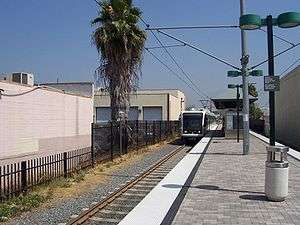
The right-of-way through the San Gabriel Valley was originally built by the Los Angeles and San Gabriel Valley Railroad in 1885. Los Angeles and San Gabriel Valley Railroad was sold and consolidated on May 20, 1887, into the California Central Railway. In 1889 this was consolidated into Southern California Railway Company. On January 17, 1906, Southern California Railway was sold to the Atchison, Topeka and Santa Fe Railway, as part of the Pasadena Subdivision. The Pasadena and Los Angeles Electric Railway built a light rail line from Los Angeles to Pasadena that opened on May 6, 1895, this later became a Pacific Electric Railway Red Car line in 1906.[13][14]
Planning
The Gold Line's initial route was formerly the right-of-way of the Atchison, Topeka and Santa Fe Railway, (the Pasadena Subdivision)[15] where passenger trains like the Southwest Chief and the Desert Wind operated until Amtrak service was re-routed along the Southern Transcon to San Bernardino via Fullerton in the early 1990s. The reuse of the line resulted in the rehabilitation and redevelopment at the site of the former Santa Fe depot.[16]
A line through Pasadena was proposed in the early 1980s as a part of a more extensive regional urban rail network, however it would not come to fruition until almost two decades later.[17] Initial planning and construction was done by Metro. After the project was halted due to a lack of funding the "Los Angeles Pasadena Blue Line Construction Authority" was established by State legislation to reactivate and complete the then 11% completed project.
The Gold Line was originally planned as a part of the Metro Blue Line. Making that connection as originally planned would require the "Regional Connector" to connect Metro Center with Union Station which is under construction.
Operation
Initial Union Station to Pasadena
The original Gold Line, between Union Station and Sierra Madre Villa, opened July 26, 2003.[18][19]
Between February 13, 2006, and December 16, 2007, the Gold Line was the first in the Metro Rail system to implement both local and express limited stop service during rush hours in both direction calling at Union Station, Highland Park, Mission, Del Mar, and Sierra Madre Villa, eliminating five minutes of travel time from end to end.
Since October 29, 2006, end-to-end travel time was reduced by five minutes, resulting in 30% less waiting time at stations, and matching the travel time of, and eliminating the need for, the express service. Ridership hit an all-time high of 21,000 boardings in September 2006.[20]
A noise barrier was constructed along the route in South Pasadena between the Mission and Fillmore stations to address noise complaints from South Pasadena residents between April 2007 and July 2007 during track construction.[18]
In December 2007, Express Service was discontinued and (local) trains began to run more frequently at 8 minute intervals. Service was increased to every 6 minutes in June 2011, as a result of increased ridership.[21]
Union Station to Eastside
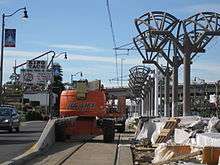
On November 15, 2009, Metro opened the first phase of the Gold Line Eastside Extension.[22][23][24] The project extended the Gold Line from Union Station to Atlantic Boulevard near Monterey Park.[25][26][27] The extended route serves Little Tokyo, Arts District, Boyle Heights and East Los Angeles.[28] The project added eight stations, two of which (Mariachi Plaza and Soto) are underground stations, only the second set of subway stations in the light rail portion of the Metro Rail system (after the 7th Street/Metro Center station).[29]
Pasadena to Azusa
The Gold Line Foothill Extension project is a multistage project to extended the Gold Line beyond Pasadena into the northeastern part of Los Angeles county and into San Bernardino County.[30] The first stage, called Phase 2A,[nb 1] running from Sierra Madre Villa station in Pasadena to APU/Citrus College station in Azusa, opened on March 5, 2016.
The construction of this segment involved replacing a steel railroad bridge at the point where the Atchison, Topeka and Santa Fe right-of-way departed from I-210 in Arcadia. Caltrans deemed the structure unsafe following the 1994 Northridge earthquake, and it was replaced by a new structure known as the Gold Line Bridge,[31] designed by Minnesota artist Andrew Leicester. The woven-basket look of the bridge's support columns emulate the famed woven baskets of the native Gabrielino/Tongva of the San Gabriel Valley while the underbelly of the bridge is supposed to evoke a Western diamondback rattlesnake.[32]
Phase 2A also included the construction of a 27-acre (11 ha)[33] new maintenance and operations facility in the city of Monrovia for servicing and storing up to 84 light rail vehicles[34][35]
Future developments
Regional Connector Transit Corridor
The Regional Connector Transit Corridor (also known as the Regional Connector, Downtown Connector or Downtown Light-Rail Connector) is an under construction light rail subway corridor through Downtown Los Angeles that is designed to connect the current Blue and Expo Lines to the current Gold Line and allow a seamless one-seat ride between the Blue and Expo Lines' current terminus at 7th Street/Metro Center and Union Station.
Once the Regional Connector Transit Corridor is completed, the northern leg of the Gold Line through the San Gabriel Valley and Azusa will be joined with the current Blue Line connecting Downtown Los Angeles and Long Beach, creating what will be the longest light rail transit line in the United States. The Eastside leg of the Gold Line will be connected to the current Expo Line, which runs between Downtown Los Angeles and Santa Monica. As part of the project, the current at-grade Gold Line Little Tokyo/Arts District station will be demolished and replaced with a new subway station with the same name approximately 500 feet south and on the opposite side of Alameda from the current station's platforms. Names and/or colors for these new lines have not yet been officially announced, but it seems likely that the Expo Line and the Eastside leg of the Gold Line will become the new Gold Line, while the current Blue Line and the Pasadena/Foothill northern section of the Gold Line will become the new Blue Line.[36] The groundbreaking for the construction of the Regional Connector Transit Corridor took place on September 30, 2014 and it is expected to be in public service by 2020.
Foothill Extension Phase 2B
_of_the_Los_Angeles_County_Metro_System.png)
A second phase of the Foothill Extension, to Montclair in San Bernardino County, had a groundbreaking ceremony on December 2 2017, with a current estimated completion date of 2026.[37]
Eastside Extension Phase 2
Metro is considering a new extension of the Metro Gold Line in the Eastside. This second phase of the Eastside Corridor would extend the Gold Line's southern leg eastward, from its current terminus at Atlantic station to Whittier.
As of August 2010, Metro has completed the Alternatives Analysis phase. The next step for Metro is to conduct an initial environmental study, leading to publication and approval of a Draft Environmental Impact Report (DEIR).[38][39]
The two alignments to be studied in the DEIR are:
- SR-60 LRT: Mixture of at-grade and aerial running along the Pomona Freeway to South El Monte
- Washington LRT: Aerial running south on Garfield Avenue and then east on Washington Boulevard to Whittier
- Or both.
Station listing
The following table lists the current stations of the Gold Line, from south to north.
| Station | Station Connections | Date Opened | City/ Neighborhood |
|---|---|---|---|
| Atlantic | Metro Local: 260 Metro Rapid: 762 Montebello Transit: 10, 40, 341, 342 El Sol: City Terrace/ELAC, Whittier Blvd/Saybrook Park |
November 15, 2009 | East Los Angeles |
| East LA Civic Center | Metro Local: 258 Montebello Transit:40 El Sol: City Terrace/ELAC, Union Pacific/Salazar Park, Whittier Blvd/Saybrook Park | ||
| Maravilla | Metro Local: 256 Montebello Transit: 40 El Sol: Union Pacific/Salazar Park, Whittier Blvd/Saybrook Park | ||
| Indiana | Metro Local: 30, 68 Shuttle (Weekdays Only), 254, 620, 665 Montebello Transit: 40 Whittier Blvd/Saybrook Park | ||
| Soto | Metro Local: 30, 251, 252, 605 Metro Rapid: 751 |
Los Angeles (Boyle Heights) | |
| Mariachi Plaza | Metro Local: 30, 620 | ||
| Pico / Aliso | Metro Local: 30 | ||
| Little Tokyo / Arts District | Metro Local: 30, 40, 330 LADOT DASH: A, D |
Los Angeles (Little Tokyo/ Arts District) | |
| Union Station | Metro Local: 40, 68, 70, 71, 78, 79 Metro Express: 442, 485, 487 Metro Rapid: 704, 728, 733, 745, 770 Amtrak Big Blue Bus: Rapid 10 FlyAway Foothill Transit: Silver Streak LADOT DASH: B, D, Lincoln Heights/Chinatown Metrolink |
July 26, 2003 | Downtown Los Angeles |
| Chinatown | Metro Local: 45, 76, 81, 83, 84, 90, 91, 94, 96 Metro Rapid: 794 LADOT DASH: B, Lincoln Heights/Chinatown LADOT Commuter Express: 409, 419 |
Los Angeles (Chinatown) | |
| Lincoln/Cypress | Metro Local:81, 84, 90, 91, 94, 251 Metro Rapid: 751, 794 |
Los Angeles (Lincoln Heights/ Cypress Park) | |
| Heritage Square | Metro Local: 81, 83 | Los Angeles (Montecito Heights) | |
| Southwest Museum | Metro Local: 81, 83 | Los Angeles (Mount Washington) | |
| Highland Park | Metro Local: 81, 83, 256 LADOT DASH: Highland Park/Eagle Rock |
Los Angeles (Highland Park) | |
| South Pasadena | Metro Local: 176 | South Pasadena | |
| Fillmore | Metro Local: 260, 686, 687 Metro Rapid: 762 Pasadena Transit: 20[40] |
Pasadena | |
| Del Mar | Metro Local: 177, 256, 260, 686, 687 Metro Express: 501[41] Metro Rapid: 762 Pasadena Transit: 20[40] | ||
| Memorial Park | Metro Local: 180, 181, 256, 260, 267, 686, 687 Metro Express: 501[41] Metro Rapid: 762, 780 Pasadena Transit: 10,[42] 20[40] | ||
| Lake | Metro Local: 180 Metro Express: 485 Pasadena Transit: 20[40] | ||
| Allen | Metro Local: 256, 686 Pasadena Transit: 10[42] | ||
| Sierra Madre Villa | Metro Local: 181, 264, 266, 268 Metro Express: 487 Foothill Transit: 187 Pasadena Transit: 31,[43] 32,[43] 40,[44] 60[45] | ||
| Arcadia[46] | Metro Local: 79, 487 Foothill Transit: 187 Arcadia Transit |
March 5, 2016 | Arcadia |
| Monrovia[46] | Metro Local: 264 Foothill Transit: 270, 494 |
Monrovia | |
| Duarte/City of Hope[46] | Metro Local: 264 Foothill Transit: 270, 272 Duarte Transit: Green, Blue |
Duarte | |
| Irwindale[46] | Foothill Transit: 185 | Irwindale | |
| Azusa Downtown[46] | Foothill Transit: 185, 187, 188, 280, 494, 690 | Azusa | |
| APU/Citrus College[46] | Foothill Transit: 187, 281, 284, 488 |
Operations
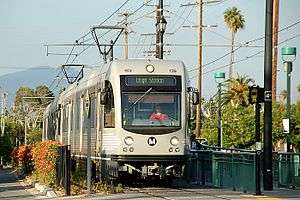
Maintenance facilities
The Gold Line is operated in both the Division 21 Yard (Los Angeles River Yard) and Division 24 yard (Monrovia yard). Division 21 is located on Vin Scully Drive (Elysian Park Drive) overlooking the Los Angeles River, and Division 24 is located south of the I-210 freeway in Monrovia. These yards stores the fleet used on the Gold Line. It is also where maintenance is done on the fleet. Trains can access these yards via a single track junction.
Rolling stock
Gold Line trains are typically two-car trains. On New Year's Day, the Gold Line uses three-car trains for service to the Tournament of Roses Parade and the Rose Bowl Game. Service operates from approximately 4 am to 1 am, with service approximately every 7 minutes during peak hours, 12 minutes middays and on weekends and 20 minutes until the close of service.
Trains are composed of articulated light rail vehicles (LRVs) which are compatible with Metro's light rail systems. As of April 2012, the Gold Line uses 50 AnsaldoBreda P2550 LRVs (701–750). P2550s have been featured in many television ads by Metro.
In April 2012, Metro transferred the last of the Gold Line's Siemens P2000 trains to the Blue Line to transfer some overhauled Nippon Sharyo P850 (100–153) cars to Expo Phase 1 while the Ansaldobreda P2550 cars replaced the Siemens P2000 trains on the Gold Line.
Commemorative cars
On December 21, 2007, Metro introduced cars 233 and 235, which are the special commemorative trains for the 119th Tournament of Roses Parade and the 94th Rose Bowl Game. These are known as the 2008 "Tournament Train".[47]
Advertising
On October 3, 2007, Metro Gold Line trains began having advertisement banners on the sides of trains, like on the Metro Green Line. On February 13, 2008, Metro removed the banner ads on all Metro Gold Line trains. But in mid-June 2008, banners promoting the Long Range Transportation Plan were added on car 246. On July 14, 2008, banner ads were added on cars 229, 235, 236, 238, 239, 244, 250 and 302.
Incidents
The following noteworthy incidents have occurred on the Gold Line since opening.
- September 11, 2007 – A driver was critically injured and six passengers, including an LA County Deputy Sheriff and the train operator, suffered minor injuries when a pickup truck ran a red light at Avenue 55 and Marmion Way before being hit by a train.[48]
- September 21, 2007 – Six people suffered non-life-threatening injuries, including two minor injuries after an SUV broke off the crossing arms and was struck by a northbound Metro Gold Line train (243) at Avenue 50 and Marmion Way in Mt. Washington. The vehicle caught fire and a section of the train was also burnt. It was claimed that the female SUV driver had tried to beat the train. A local resident extinguished the fire in the car with a garden hose before Los Angeles Firefighters arrived.[49]
- October 13, 2007 – Service was suspended for 12 hours at 1:20 am after a big rig hit the center divider of the eastbound Foothill Freeway at Sierra Madre Blvd. and went on the Metro Gold Line tracks. During the course of the accident, buses were provided to bypass the accident site.[50]
- August 26, 2011 – An altercation between passengers resulted in a non-fatal stabbing during a trip through Pasadena. The train was stopped at the Memorial Park station where the victim was transported to a hospital and the suspect was detained.[51]
- April 24, 2014 – Service was suspended between the Lake and Sierra Madre Villa stations after a collision between two tractor-trailers on the eastbound Foothill Freeway resulted in one vehicle landing on the Gold Line tracks, damaging the tracks and overhead wires. Full return to normal service took several days.[52]
- March 6, 2016 - Service between Allen and Arcadia stations were disrupted for most of the evening - resuming Monday morning - one day after the opening of the Foothill Extension when a semi-truck driver lost control and sent his trailer onto the tracks.[53]
- December 29, 2016 - A pedestrian was struck and killed by a train heading eastbound into the Arcadia station at 12:12 am. Full service was restored by 5:30 am.[54]
- October 1, 2017 - A woman was fatally struck on a set of tracks at Pasadena Avenue and Monterey Road. The crash occurred about 7:35 AM.[55]
- February 20, 2018 - A high speed pursuit ended in the Gold Line tunnel between Soto and Indiana stations, suspending service between Pico/Aliso and Indiana occurring around 10:00 PM. One male suspect was arrested as the female escaped. [56]
- April 26, 2018 - Once again, an accident on the I-210 freeway involving a FedEx truck that ended up on the Gold Line tracks in both directions between Lake and Memorial Park stations, damaging both the wires and the rails. This was only a day after when the line was suspended in Highland Park and South Pasadena for damaged wires.
Gallery
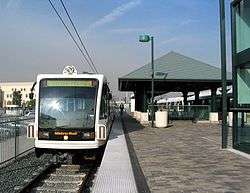 A Siemens P2000 train (the old Gold Line train) stationing at Union Station.
A Siemens P2000 train (the old Gold Line train) stationing at Union Station. Gold Line train crosses W Avenue 33 at Artesian St with gates down, northeast of Lincoln Heights / Cypress Park Station
Gold Line train crosses W Avenue 33 at Artesian St with gates down, northeast of Lincoln Heights / Cypress Park Station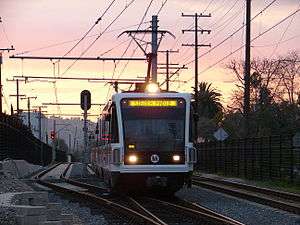 A Siemens P2000 train (the old Gold Line train) runs through South Pasadena.
A Siemens P2000 train (the old Gold Line train) runs through South Pasadena.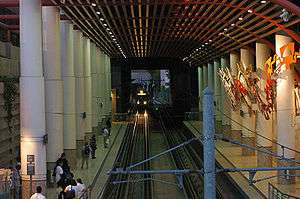 Memorial Park Station in Pasadena. This station is in an open cut. Memorial Park is to the left and the Holly Street Apartments are directly above the tracks
Memorial Park Station in Pasadena. This station is in an open cut. Memorial Park is to the left and the Holly Street Apartments are directly above the tracks Construction (2014) of the Gold Line, near Duarte, CA. Tracks are laid, but overhead catenary has not been installed yet.
Construction (2014) of the Gold Line, near Duarte, CA. Tracks are laid, but overhead catenary has not been installed yet. Kinkisharyo P3010 after entering service on March 5, 2016 at Highland Park Station.
Kinkisharyo P3010 after entering service on March 5, 2016 at Highland Park Station.
References
- 1 2 3 "Ridership Statistics - Rail Ridership Estimates". LACMTA. Retrieved 2016-03-08.
- 1 2 "Monthly Ridership Plot" (PDF). LACMTA. November 2013. Retrieved 2013-11-16.
- ↑ https://www.metro.net/projects/eastside_phase2/
- ↑ https://media.metro.net/projects_studies/eastside_phase2/images/factsheet_eastsidephase2_en_2017-11.pdf
- ↑ https://www.metro.net/projects/foothill-extension/
- ↑ https://foothillgoldline.org/construction_phases/glendora_to_montclair/
- ↑ https://www.metro.net/projects/foothill-extension/
- ↑ https://foothillgoldline.org/construction_phases/glendora_to_montclair/
- 1 2 3 "Facts at a Glance". LACMTA. Retrieved 2016-03-08.
- ↑ Guccione, Jean (November 17, 2006). "1st of two Eastside rail tunnels is finished". Los Angeles Times. Retrieved 2016-01-17.
- 1 2 3 4 5 "Gold Line timetable" (PDF). LACMTA. December 15, 2013. Retrieved 2014-02-05.
- 1 2 3 "Metro Bus & Rail System Map" (PDF). LACMTA. December 2013. Retrieved 2014-01-15.
- ↑ Historic Pasadena: An Illustrated History, By Ann Scheid, Ann Scheid Lund, page 31-32.
- ↑ Abandon Rail Line, The Second District of the AT&SF
- ↑ Hawthorne, Christopher (May 20, 2016). "Why the Expo Line to Santa Monica marks a rare kind of progress in American cities". Los Angeles Times. Retrieved 12 July 2016.
- ↑ Rasmussen, Cecilia (July 13, 2003). "Pasadena's Gold Line Will Travel a History-Laden Route". Los Angeles Times. Retrieved 19 January 2016.
- ↑ Freemark, Yonah (March 26, 2010). "Los Angeles' Gold Line Foothill Extension Approved for Funding, Will Begin Construction Later this Year". The Transport Politic. Retrieved 12 March 2016.
- 1 2 Streeter, Kurt (June 19, 2003). "Gold Line Is Set to Open July 26". Los Angeles Times. Retrieved 14 March 2016.
- ↑ Lund, Dr. Hollie & Willson, Dr. Richard W. (April 2005), The Pasadena Gold Line: Development Strategies, Location Decisions, and Travel Characteristics along a New Rail Line in the Los Angeles Region (PDF), San Jose, CA: Mineta Transportation Institute
- ↑ "Metro Gold Line Trains Now Run Faster, More Frequently". LACMTA. November 3, 2006. Retrieved 16 November 2013.
- ↑ Hymon, Steve (June 21, 2011). "More frequent Gold Line and Silver Line service begins soon". The Source. LACMTA. Retrieved 16 November 2013.
- ↑ Bloomekatz, Ari B. (November 13, 2009). "Q&A : Gold Line links downtown and East L.A. : The 6-mile light-rail extension, which cost $898 million, will open Sunday with free rides and entertainment". Los Angeles Times. Retrieved 14 March 2016.
- ↑ Bloomekatz, Ari B. (December 21, 2011). "L.A.'s historic 1st Street bridge reopens after 3-year closure". Los Angeles Times. Retrieved 14 March 2016.
- ↑ Becerra, Hector (June 16, 2009). "Making the Eastside safe for Gold Line light rail extension". Los Angeles Times. Retrieved 14 March 2016.
- ↑ Becerra, Hector (April 24, 2009). "MTA approves Spanish name for Gold Line light rail Eastside extension". Los Angeles Times. Retrieved 14 March 2016.
- ↑ Liu, Caitlin (November 26, 2005). "School in Light-Rail's Path a Study in Complexity of Transit Planning". Los Angeles Times. Retrieved 14 March 2016.
- ↑ Becerra, Hector (September 12, 2009). "Glitches and finishing touches on Gold Line extension to East L.A." Los Angeles Times. Retrieved 14 March 2016.
- ↑ Chong, Jia-Rui (October 1, 2005). "Growing Pains Along the Gold Line". Los Angeles Times. Retrieved 14 March 2016.
- ↑ Sampson, Rich. "Two Rail Lines, One Mission: Connecting Southern California" (PDF). RAIL Magazine (22). Washington, DC: Community Transportation Association of America. Retrieved 14 March 2016.
- ↑ Scauzillo, Steve (February 17, 2015). "Gold Line authority makes push for next extension from Azusa to Montclair". San Gabriel Valley Tribune. Retrieved 13 March 2016.
- ↑ "Foothill Extension News" (PDF). Gold Line Foothill Construction Authority. December 2009. Retrieved 2010-09-21.
- ↑ "Art of the Journey, The Foothill Gold Line" (PDF). Foothill Gold Line Construction Authority. Retrieved 24 August 2014.
- ↑ "Press Release, Light Rail Maintenance Facility Approved" (PDF). Gold Line Foothill Construction Authority. January 19, 2011. Retrieved 2011-01-20.
- ↑ Ed Reyes, L.A. City Council (December 16, 2009). "Letter to Ara Najarian, Chair of Metro Board" (PDF). Retrieved 2010-09-21.
- ↑ "Project Overview and Status, presentation to the Design-Build Institute of America" (PDF). March 10, 2010. Retrieved 2010-09-21.
- ↑ "Conceptualized Regional Connector Map" (PDF). LA Metro. Retrieved June 30, 2016.
- ↑ https://la.curbed.com/2017/6/23/15858170/metro-gold-line-extension-claremont-montclair
- ↑ "Eastside Transit Corridor Phase 2". LACMTA. December 16, 2011. Retrieved 2013-11-16.
- ↑ "Metro Narrows Routes for Gold Line East Down to Two". EGP.COM. Eastern Group Publications, Inc. August 28, 2014.
- 1 2 3 4 http://ww5.cityofpasadena.net/pasadena-transit/wp-content/uploads/sites/33/2015/12/PT-RT-20-Schedule-Web.pdf
- 1 2 "Metro 501 Timetable" (PDF). LACMTA. Retrieved February 17, 2016.
- 1 2 http://ww5.cityofpasadena.net/pasadena-transit/wp-content/uploads/sites/33/2015/12/PT-RT-10-Schedule-web.pdf
- 1 2 http://ww5.cityofpasadena.net/pasadena-transit/wp-content/uploads/sites/33/2015/12/RT-31_32-Schedule-web.pdf
- ↑ http://ww5.cityofpasadena.net/pasadena-transit/wp-content/uploads/sites/33/2015/12/PT-RT-40-web.pdf
- ↑ http://ww5.cityofpasadena.net/pasadena-transit/wp-content/uploads/sites/33/2015/12/PT-RT-60-Schedule-web.pdf
- 1 2 3 4 5 6 "Metro 804 Timetable" (PDF). LACMTA. Archived from the original (PDF) on March 1, 2016. Retrieved 18 February 2016.
- ↑ "L.A. Metro, Rose Queen® and Royal Court Roll Out Special Commemorative Metro Gold Line Train for 119th Tournament of Roses Parade and 94th Rose Bowl Game®". LACMTA. December 21, 2007. Retrieved 2013-11-16.
- ↑ Blankstein, Andrew; Abdollah, Tami (September 12, 2007). "7 hurt when Gold Line train hits truck at Highland Park crossing". Los Angeles Times. Retrieved 2014-12-05.
- ↑ Abdollah, Tami; Rabin, Jeffrey L. (September 22, 2007). "6 hurt when Gold Line train hits vehicle". Los Angeles Times. Retrieved 2014-12-05.
- ↑ "Big rig hits Gold Line tracks, causes traffic". Eagle Rock News. October 2007. Archived from the original on September 23, 2015. Retrieved December 22, 2014.
- ↑ Knoll, Corina (August 27, 2011). "Gold Line stabbing victim in critical but stable condition". Los Angeles Times. Retrieved 2014-12-05.
- ↑ Allen, Lily (April 24, 2014). "Gold Line service suspended between Lake and Sierra Madre Villa stations due to freeway truck accident". The Source. LACMTA. Retrieved 2014-07-17.
- ↑ Day, Brian (March 7, 2016). "Fiery crash on 210 Freeway severs just-opened Gold Line between Pasadena, Arcadia". San Gabriel Tribune. Retrieved 7 March 2016.
- ↑ Sklar, Debbie (December 29, 2016). "Death on the tracks: Suicide or accident in Arcadia?". Retrieved 29 December 2016.
- ↑ Day, Brian (October 1, 2017). "Woman fatally struck by Gold Line train in South Pasadena". Retrieved 1 October 2017.
- ↑ http://www.latimes.com/local/lanow/la-me-tunnel-police-pursuit-charged-20180222-story.html
- ↑ The entire Foothill Extension is numbered Phase 2, with the original Union Station to Pasadena Gold Line segment being thought of as Phase 1. This is somewhat of a misnumbering, as the Gold Line Eastside Extension was built between these two phases, but long-range plans call for the Union Station to Montclair and Union Station to East Los Angeles branches to be run as separate lines.
External links
| Wikimedia Commons has media related to LACMTA Gold Line. |
Route map:
